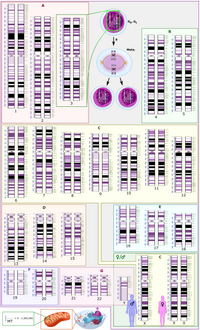
Prevalence of human papillomavirus in head and neck cancers at tertiary care centers in the United States over time
Sign Up to like & getrecommendations! Published in 2022 at "Cancer"
DOI: 10.1002/cncr.34124
Abstract: Human papillomavirus (HPV) is responsible for a growing proportion of oropharyngeal squamous cell carcinomas (OPSCCs) among men and White individuals. Whether similar trends apply to women, non‐Whites, and non‐oropharyngeal squamous cell carcinomas (non‐OPSCCs) is unknown. read more here.
Keywords: papillomavirus; head neck; prevalence human; neck cancers ... See more keywords

Novel cytomorphologic characteristics suggesting human papillomavirus infection in patients diagnosed as negative for intraepithelial lesion or malignancy and a comparison of diagnostic performance of three human papillomavirus tests
Sign Up to like & getrecommendations! Published in 2018 at "Diagnostic Cytopathology"
DOI: 10.1002/dc.24049
Abstract: Although the Papanicolaou (Pap) test is the first‐line screening method for cervical cancer, it has low sensitivity for detection of human papillomavirus (HPV)‐infected cervical lesion compared to the HPV test. The aims of this study… read more here.
Keywords: infection patients; novel cytomorphologic; diagnosed negative; human papillomavirus ... See more keywords

Psychosocial impact of testing human papillomavirus positive in Australia's human papillomavirus‐based cervical screening program: A cross‐sectional survey
Sign Up to like & getrecommendations! Published in 2022 at "Psycho-Oncology"
DOI: 10.1002/pon.5897
Abstract: To examine the impact of self‐reported human papillomavirus (HPV) test result (HPV negative, HPV positive, HPV result unknown) on a range of psychosocial outcomes. read more here.
Keywords: papillomavirus; psychosocial impact; hpv; human papillomavirus ... See more keywords

Complete genome sequence of a novel fish papillomavirus detected in farmed wels catfish (Silurus glanis)
Sign Up to like & getrecommendations! Published in 2021 at "Archives of Virology"
DOI: 10.1007/s00705-021-05123-w
Abstract: A novel papillomavirus (PV) was detected in farmed wels catfish (Silurus glanis) in Hungary showing clinical signs resembling those of wels catfish herpesvirus disease. The whole genome of Silurus glanis papillomavirus 1 (SgPV1) was identified… read more here.
Keywords: wels catfish; silurus glanis; genome; papillomavirus ... See more keywords

The effect of intrauterine devices on acquisition and clearance of human papillomavirus
Sign Up to like & getrecommendations! Published in 2017 at "American Journal of Obstetrics and Gynecology"
DOI: 10.1016/j.ajog.2016.11.1053
Abstract: BACKGROUND: Previous studies have shown a decrease in cervical cancer associated with intrauterine device use. It has been hypothesized that intrauterine device use may alter the natural history of human papillomavirus infections, preempting development of… read more here.
Keywords: papillomavirus; intrauterine device; device use; human papillomavirus ... See more keywords

National Trends in Human Papillomavirus Awareness and Knowledge of Human Papillomavirus-Related Cancers.
Sign Up to like & getrecommendations! Published in 2019 at "American journal of preventive medicine"
DOI: 10.1016/j.amepre.2018.11.005
Abstract: INTRODUCTION The President's Cancer Panel released a report in 2014 calling for communication strategies to promote the human papillomavirus vaccine among males and females. The purpose of this study was to (1) estimate changes in… read more here.
Keywords: awareness; knowledge; papillomavirus related; human papillomavirus ... See more keywords

Mechanism of a new photosensitizer (TBZPy) in the treatment of high-risk human papillomavirus-related diseases.
Sign Up to like & getrecommendations! Published in 2021 at "Photodiagnosis and photodynamic therapy"
DOI: 10.1016/j.pdpdt.2021.102591
Abstract: BACKGROUND High-risk human papillomavirus infection is closely related to the development of several diseases, including cervical cancer and condyloma acuminatum. We recently designed a new photosensitizer, 1-triphenylaminebenzo[c][1,2,5]thiadiazole-4-yl)styryl)-1-methylpyridin-1-ium iodide salt (TBZPy), which shows good photodynamic properties.… read more here.
Keywords: tbzpy; high risk; risk human; human papillomavirus ... See more keywords

Integrated analysis of recombinant BPV-1 L1 protein for the production of a bovine papillomavirus VLP vaccine.
Sign Up to like & getrecommendations! Published in 2017 at "Vaccine"
DOI: 10.1016/j.vaccine.2017.02.007
Abstract: Bovine papillomatosis is an infectious disease that is caused by bovine papillomavirus (BPV), which results in important economic losses. However, no BPV vaccines or effective treatment methods are commercially available to date. Moreover, the absence… read more here.
Keywords: bpv; protein; production; bovine papillomavirus ... See more keywords

Whole-Genome Analysis of Human Papillomavirus Types 16, 18, and 58 Isolated from Cervical Precancer and Cancer Samples in Chinese Women
Sign Up to like & getrecommendations! Published in 2017 at "Scientific Reports"
DOI: 10.1038/s41598-017-00364-9
Abstract: Human papillomavirus (HPV) types 16, 18 and 58 are ranked the top three high-risk HPV types for cervical intraepithelial neoplasia (CIN) and invasive carcinoma. We aimed to evaluate the diversity of HPV16, HPV18, and HPV58… read more here.
Keywords: whole genome; analysis human; genome analysis; human papillomavirus ... See more keywords

Stress keratin 17 and estrogen support viral persistence and modulate the immune environment during cervicovaginal murine papillomavirus infection.
Sign Up to like & getrecommendations! Published in 2023 at "Proceedings of the National Academy of Sciences of the United States of America"
DOI: 10.1073/pnas.2214225120
Abstract: A murine papillomavirus, MmuPV1, infects both cutaneous and mucosal epithelia of laboratory mice and can be used to model high-risk human papillomavirus (HPV) infection and HPV-associated disease. We have shown that estrogen exacerbates papillomavirus-induced cervical… read more here.
Keywords: estrogen; papillomavirus; disease; infection ... See more keywords

Genomic coevolution of papillomavirus and immune system in placental mammals indicates the role of IFN-γ in the emergence of new variants.
Sign Up to like & getrecommendations! Published in 2023 at "Carcinogenesis"
DOI: 10.1093/carcin/bgad007
Abstract: Papillomaviruses (PVs) are causative agents for warts and cancers in different parts of the body in the mammalian lineage. Therefore, these viruses are proposed as model organisms to study host immune responses to pathogens causing… read more here.
Keywords: papillomavirus; role; air; ifn ... See more keywords